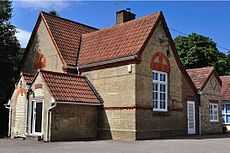Primary school

A primary school, or elementary school, is a school in which children receive primary or elementary education between the ages of about five to about eleven, coming before secondary school and after preschool. It is the first stage of compulsory education in most parts of the world, and is normally available without charge, but may be a fee-paying independent school.
The term primary school is derived from the French école primaire, which was first used in 1802.[1]
- Primary school is the preferred term in the United Kingdom and many Commonwealth Nations, and in most publications of the United Nations Educational, Scientific, and Cultural Organization (UNESCO).[2]
- Elementary school is preferred in some countries, especially in North America.
The term grade school is sometimes used. The terms first school or infant school may also used though these, strictly speaking, refer to different educational programs.
In some places, primary schooling has historically further been divided between lower primary schools (LP schools), which were the elementary schools, and higher primary schools (HP schools), which were established to provide a more practical instruction to poorer classes than what was provided in the secondary schools.[3]
See also
References
- ↑ "Online Etymology Dictionary".
- ↑ Primary school. In Encyclopædia Britannica. Retrieved on 12 June 2007, from Encyclopædia Britannica Online: http://search.eb.com/eb/article-9061377
- ↑ Bruce Ryburn Payne, Public Elementary School Curricula: A Comparative Study of Representative Cities of the United States, England, Germany and France (1905), p. 155.
| |||||||||||||||||||||||||||||||||||
| ||||||||||||||||||||||||||||||||||
